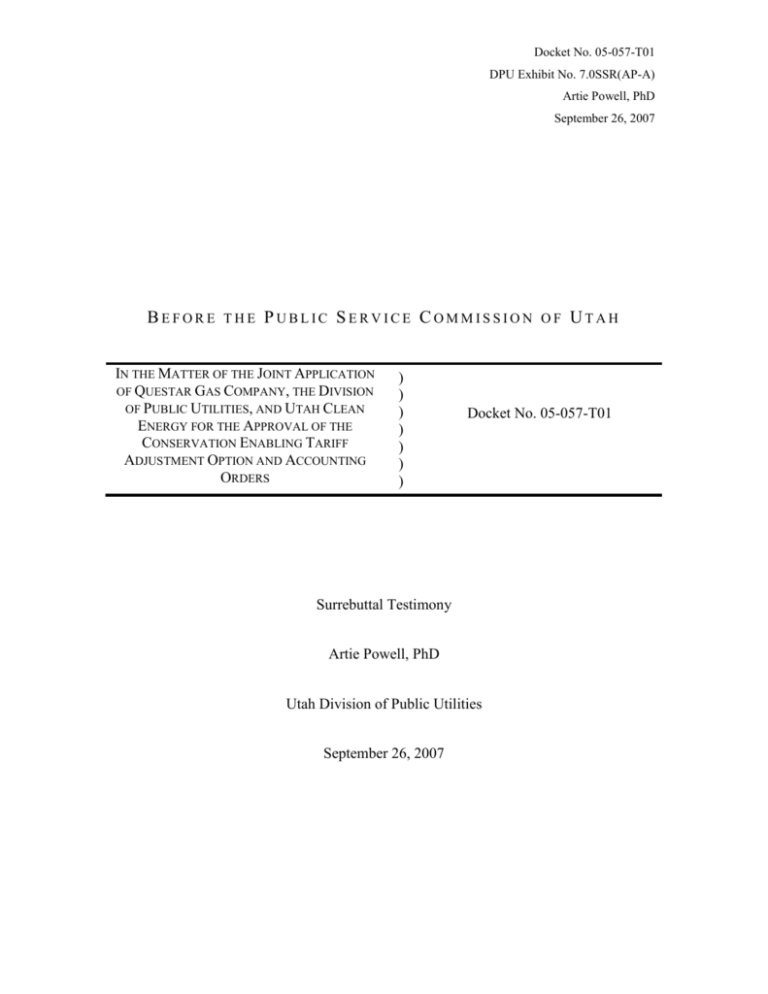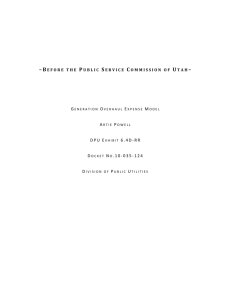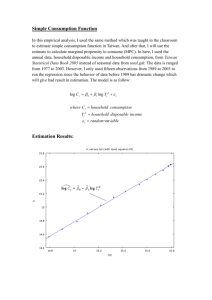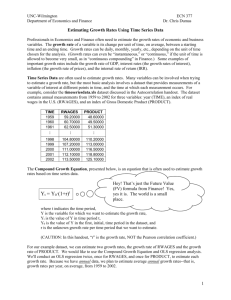“It should be clear that the sample size is important
advertisement

Docket No. 05-057-T01 DPU Exhibit No. 7.0SSR(AP-A) Artie Powell, PhD September 26, 2007 BEFORE THE PUBLIC SERVICE COMMISSION IN THE MATTER OF THE JOINT APPLICATION OF QUESTAR GAS COMPANY, THE DIVISION OF PUBLIC UTILITIES, AND UTAH CLEAN ENERGY FOR THE APPROVAL OF THE CONSERVATION ENABLING TARIFF ADJUSTMENT OPTION AND ACCOUNTING ORDERS ) ) ) ) ) ) ) UTAH Docket No. 05-057-T01 Surrebuttal Testimony Artie Powell, PhD Utah Division of Public Utilities September 26, 2007 OF Docket No. 05-057-T01 DPU Exhibit No. 7.0SSR(AP-A) Artie Powell, PhD September 26, 2007 1 Q: Would you state your name, employer, and for whom you are testifying? 2 A: My name is Artie Powell; I am employed by and testifying for the Division of 3 Public Utilities. 4 Q: Have you submitted testimony before in this proceeding? 5 A: Yes, in this phase of the proceeding I submitted rebuttal testimony on August 8, 6 2007. 7 Q: What is the purpose of this testimony? 8 A: In lieu of striking portions of his testimony, the Commission allowed parties to respond in writing to Dr. Dismukes’ surrebuttal testimony within five working 9 10 days. The purpose of my testimony is to provide limited response to the 11 regression analysis presented in Dr. Dismukes’ surrebuttal testimony and 12 summarized in Exhibits attached to his testimony: Exhibit SR CCS 2.2 and 13 Exhibit SR CCS 2.3 (corrected exhibit numbers). Specifically, I offer expert 14 commentary on the regression methods and results presented by Dr. Dismukes in 15 these two models. 16 Q: Would you briefly summarize your qualifications? 17 A: I have a doctorate degree in economics from Texas A&M University with a major 18 field in econometrics. Econometrics is a subfield of economics, which applies 19 mathematical and statistical theory, tools, and techniques to the analysis, 20 interpretation and presentation of economic data. As a graduate student, I Page 2 of 15 Docket No. 05-057-T01 DPU Exhibit No. 7.0SSR(AP-A) Artie Powell, PhD September 26, 2007 21 completed approximately a dozen graduate courses in econometrics, statistics, 22 mathematics and mathematical economics. From 1985 to 2005, I taught 23 economics, econometrics and statistics at the university level. From 1989 to 24 1995, I taught full-time at the University of Mississippi and helped coordinate the 25 undergraduate and MBA statistical classes for the School of Business. From 1996 26 to 2005, I taught as an adjunct professor at Weber State University. 27 Q: 28 29 Would you briefly explain your concerns with Dr. Dismukes regression analysis? A: I have several concerns with the regression models and results provided by Dr. 30 Dismukes in surrebuttal testimony purporting to show that there is a significant 31 price effect on usage at the state level or specifically for Questar’s GS customers. 32 Specifically, Dr. Dismukes failed to account for the effects of autocorrelation in 33 his regression models, which by itself renders the results of his models suspect. 34 In addition, in the first of his regression models (Exhibit SR CCS 2.2; corrected 35 exhibit numbering), the sample size is relatively small which makes drawing valid 36 conclusions difficult. Thus, the regression analysis, results and conclusions 37 drawn by Dr. Dismukes in his surrebuttal testimony are suspect. 38 Q: Could you briefly describe Dr. Dismukes’ first model? 39 A: In his first model (CCS Exhibit SR CCS-2.2), Dr. Dismukes regresses the natural 40 log (LN) of usage per customer against four variables, (1) LN of price, (2) LN of Page 3 of 15 Docket No. 05-057-T01 DPU Exhibit No. 7.0SSR(AP-A) Artie Powell, PhD September 26, 2007 41 price lagged one year, (3) LN of a weather variable, and (4) a time trend. 42 Algebraically, the model can be written as: y X 0 1 X1 2 X 2 3 X 3 4 X 4 43 44 (1) where the dependent variable is 45 y = the natural log of usage per customer; 46 and the independent or explanatory variables are: 47 X0 = an intercept (column of ones); 48 X1 = the natural log of the annual price; 49 X2 = the natural log of the annual price lagged one year; 50 X3 = the natural log of a weather variable; and 51 X4 = a time trend represented by the year (1998, 1999, …, 2005). 52 Q: What is your first concern with this model? 53 A: My first concern with this model is the sample size: there are only eight (8) 54 observations.1 (See Table 1; data provided by the Committee of Consumer 55 Services in response to DPU data request 5.1). 56 1 Dr. Dismukes lists nine (9) observations, but since the model contains a lag on the price variable only 8 observations are used in the model and analysis. Page 4 of 15 Docket No. 05-057-T01 DPU Exhibit No. 7.0SSR(AP-A) Artie Powell, PhD September 26, 2007 57 Table 1: CCS Model 1 Annual Data Y Var X1 Var X2 Var X3 Var X4 Var lnUsePerCustomer lnPrice lnPriceLag lnHdd Year 4.63178805 1.85248010 8.73520359 1997 4.57468590 1.91285694 1.85248010 8.72176536 1998 4.51436681 1.84989693 1.91285694 8.66836802 1999 4.46606133 1.95815831 1.84989693 8.66888370 2000 4.42675714 2.19260553 1.95815831 8.70334075 2001 4.49891659 1.93963770 2.19260553 8.78063380 2002 4.38807447 2.05339214 1.93963770 8.64611397 2003 4.45794802 2.12777764 2.05339214 8.78109474 2004 4.35715740 2.27282668 2.12777764 8.73004395 2005 58 59 With eight observations and five explanatory variables (including the 60 intercept), there are only three (3) degrees of freedom. In statistics, the term 61 degrees of freedom (DF) is a measure of the number of independent pieces of 62 information on which the precision of a parameter estimate is based. Generally 63 speaking, the greater the DF, the more reliable or precise estimates are. Generally 64 speaking, a larger sample size would increase the DF and improve the reliability 65 of the model and its results. 66 67 An acceptable sample size will depend on a number of factors including the number of regressors in the model, the desired level of accuracy of each Page 5 of 15 Docket No. 05-057-T01 DPU Exhibit No. 7.0SSR(AP-A) Artie Powell, PhD September 26, 2007 68 parameter being estimated and the desired level of model power (R2). One “rule 69 of thumb” suggests that for every parameter to be estimated you should have 30 70 data points or observations.2 A more precise formula for computing the minimum 71 sample size is given by: Z n E 72 2 1 R2 1 Rxx2 j k (2) 73 Where Z is the critical value corresponding to the standard normal distribution for 74 a given test size (α); E is the desired margin of error or half of the width of the 75 desired confidence interval for βj; R2 is the desired explanatory power of the 76 model or coefficient of determination; Rxx2 j is the desired coefficient of 77 determination for a model regressing Xj on the other regressors or explanatory 78 variables of the model; and k is the total number of regressors including the 79 intercept.3 See for example, William Mendenhall, James E. Reinmuth, and Robert J. Beaver, “Statistics for Management and Economics,” 7th ed., [Belmont, California: Duxbury Press, 1993], pp.251-261. 2 Ken Kelly and Scott E. Maxwell, “Sample Size for Multiple Regression: Obtaining Regression Coefficients That Are Accurate, Not Simply Significant,” Psychological Methods, (Vol. 8, No. 3), 2003, pp. 305-321. As the authors explain, the formula given here will result in a confidence interval no larger than the desired width (E) about 50% of the time. Thus, the formula can be considered a conservative estimate of the sample size. That is, the actual sample size necessary to ensure a confidence interval no greater than E may be considerably larger than that calculated from Equation (2). 3 Page 6 of 15 Docket No. 05-057-T01 DPU Exhibit No. 7.0SSR(AP-A) Artie Powell, PhD September 26, 2007 As an example, suppose we use a test size of five percent (α = 0.05, Z = 80 81 1.96), R2 = 0.80, Rxx2 j = 0.70, and k = 5, then to achieve a sample size of only 30, 82 the margin of error would be approximately E = 0.3. If we assume that the “true” 83 price elasticity from Dr. Dismukes’ model (β1) is between -0.5 to -0.01, then a 84 margin of error of E = 0.3 seems relatively large.4 If we use a margin of error E = 85 0.15, then the minimum sample size would be n = 119. Of course, the necessary 86 sample size will vary depending on the values chosen for Z, E, R2, and Rxx2 j but, I 87 think this illustrates that we would have expected a sample size of more than 30 88 and possibly more than 100 in order to ensure the accuracy or reliability of the 89 models estimates. As one expert states, 90 91 92 93 It should be clear that the sample size is important. When the sample size is too small, the analyst cannot compute adequate measures of error in the regression results, and there can be no basis for checking model assumptions.5 Given the small sample, drawing valid conclusions from Dr. Dismukes’ 94 95 models is problematic. Compounding the problem is the likelihood that 96 autocorrelation is present in this type of data. Given a margin of error E = 0.3, any estimate of β1 greater than -0.3 would be insignificant. For example, given and estimate of -0.1, the 95 percent confidence interval would be -0.1 ± 0.3, or -0.4 to 0.2. 4 Raymond H. Myers, “Classical and Modern Regression with Applications,” 2 nd Ed., [Boston, Massachusetts: PWS-Kent Publishing Company, 1990], p. 6. 5 Page 7 of 15 Docket No. 05-057-T01 DPU Exhibit No. 7.0SSR(AP-A) Artie Powell, PhD September 26, 2007 97 Q: 98 99 You indicated that autocorrelation might be problem. Could you explain your concern about autocorrelation? A: Autocorrelation is a violation of one of the basic assumptions in regression 100 models and refers to the dependent relationship among the regression errors (ε). 101 When using economic data, it is not unusual for the regression errors to follow a 102 first order autoregressive process: t t 1 ut 103 t 2, 3, ..., T (3) 104 where εt is the error term for observation “t”; εt-1 is the error term for observation 105 “t-1”; ρ is the correlation coefficient between εt and εt-1; and ut is an error term 106 that satisfies the fundamental regression assumptions6. As one author explains, 107 108 109 The presence of the autocorrelation causes difficulty in the estimation of error variance and, as a result, in tests of hypotheses and confidence interval estimation.7 110 The presence of autocorrelation, in other words, would make it difficult to 111 draw valid conclusions from Dr. Dismukes’ regression results. I would note, that 112 the presence of positive autocorrelation (ρ >0), which is typical of economic data, 113 makes it doubly difficult: The error terms ut (t = 2, 3, …, T) are identically, independently, normally distributed random variables: u ~ IIN(0, σ2I), where u is the T-1x1 vector of errors and I is an identity matrix of dimension T-1. 6 7 Myers, p. 288. Page 8 of 15 Docket No. 05-057-T01 DPU Exhibit No. 7.0SSR(AP-A) Artie Powell, PhD September 26, 2007 114 115 116 117 118 The existence of positively correlated errors can result in an estimate of 2 [error variance] that is a substantial underestimate. This, of course, tends to inflate t-statistics on coefficients and deflate the width of confidence intervals on coefficients.8 119 A simple test for first-order autoregression based on the fitted residuals 120 (et) is known as the Durbin-Watson test.9 The test statistic “d” is given by the 121 formula: e T d 122 t 2 t et 1 T e t 1 123 2 (4) 2 t Lower (dL) and upper (dU) bounds (or critical values) for the Durbin- 124 Watson statistic are specified with respect to the sample size (T) and the desired 125 testing or confidence level ( ). The traditional Durbin-Watson test10 for positive 126 autocorrelation, where ρ is the correlation coefficient for the models error terms, 127 is: 128 Reject H0: 0 , if d < dL; 129 Fail to reject H0: 0 , if d > dU; and 130 Declare the test inconclusive if dL < d < dU. 8 Myers, p. 288, (emphasis added). 9 Myers, pp. 289-290. 10 The null and alternative hypotheses for positive autocorrelation are respectively H 0: ρ < 0 and Ha: ρ ≥ 0. Page 9 of 15 Docket No. 05-057-T01 DPU Exhibit No. 7.0SSR(AP-A) Artie Powell, PhD September 26, 2007 131 However, there are two important qualifications or conditions to the use of 132 the Durbin-Watson test. First, the regression must contain an intercept term. 133 Second, the independent variables cannot contain a lagged dependent variable.11 134 Dr. Dismukes’ first regression meets both conditions. However, the inconclusive 135 range presents an especially particularly “awkward problem” in small samples.12 136 This is illustrated in tables of critical values for the Durbin-Watson test by 137 the absence of computed values for small samples and relatively large numbers of 138 regression variables. For example, Johnston reports critical values starting with 139 samples as small as six observations but lacks values when there is more than one 140 independent variable. Indeed, for a given set of regressors, as the sample size 141 declines it appears that the inconclusive range widens to the point where the test is 142 incapable of detecting autocorrelation even if it exist. Given five regressors 143 (including the intercept) and 100 observations, the inconclusive range is from 144 1.592 to 1.758 (a difference of 0.166); with 50 observations the range is 1.378 to 145 1.721 (a difference of 0.343); with 10 observations the range is 0.376 to 2.414 (a 146 difference of 2.038); and with 8 observations no critical values are reported.13 J. Johnston, “Econometric Methods,” 3rd ed., [New York, New York: McGraw-Hill Book Company, 1984], p.316. 11 12 Johnston, p. 316. For large samples, the Durbin-Watson statistic will approximately equal d = 2(1 – ρ). Since ρ, the correlation coefficient, is a number between -1 and 1, d will range between 0 and 4. Values close to 2 (ρ = 0) indicate the absence of autocorrelation. Since the statistical distribution of d is unknown, critical values, 13 Page 10 of 15 Docket No. 05-057-T01 DPU Exhibit No. 7.0SSR(AP-A) Artie Powell, PhD September 26, 2007 147 Given that Dr. Dismukes’ model contains only 8 observations, the 148 application of the Durbin-Watson test is impractical. However, a visual 149 inspection of the error terms from his model indicates the presence of positive 150 autocorrelation. The typical pattern for positive autocorrelation is for some 151 sequential errors (or residuals) to be positive change to negative for a group of 152 sequential errors and then switch to negative again. This pattern is repeated for 153 the entire sample similar to a sine wave. A plot of the errors from Dr. Dismukes’ 154 model is provide in Figure 1. 155 dL and dU, are estimated using Monte Carlo simulations. In essence, when the sample size is too small, the critical values become 0 and 4, and the test is unable to detect the presence of autocorrelation when it exists. Page 11 of 15 Docket No. 05-057-T01 DPU Exhibit No. 7.0SSR(AP-A) Artie Powell, PhD September 26, 2007 156 Figure 1: Error Plot from Dr. Dismukes’ Model 1 0.01 Residuals (Errors) 0.01 0.00 -0.01 -0.01 -0.02 -0.02 1996 1998 2000 2002 2004 2006 Time Trend (Year) 157 158 159 In the first of Dr. Dismukes’ models, the sample size is relatively small at 160 T = 8. With five regressors, that leaves only three (3) degrees of freedom. 161 Additionally, the Durbin-Watson statistic is 1.75. However, it appears that the 162 sample size is too small to carry out the hypothesis test for the presence of 163 autocorrelation: it appears that upper and lower bounds are not tabulated for Page 12 of 15 Docket No. 05-057-T01 DPU Exhibit No. 7.0SSR(AP-A) Artie Powell, PhD September 26, 2007 164 sample sizes this small with five regressors.14 A graphical plot of the error terms 165 against the time trend variable does suggest that autocorrelation is present. Given 166 the small sample size and the apparent presence of autocorrlation in the data, 167 drawing valid conclusions from this model is difficult. 168 Q: 169 170 Could you explain how these concerns relate to Dr. Dismukes’ second regression model? A: The Division submitted a data request to the Committee asking for information on 171 the diagnostic test performed by Dr. Dismukes for his second regression model 172 (Exhibit SR CCS 2.3; corrected exhibit numbering). This is the data request that 173 the Commission instructed the Committee to clarify. For convenience, the 174 request and response are reproduced in Table 2. 175 From Dr. Dismukes’ response to the data request, it appears that positive 176 autocorrelation is present in the data for model 2 (Exhibit SR CCS 2.3; corrected 177 exhibit number). That is, the P-value for the Durbin-Watson statistic is less than 178 0.0001, which indicates that we would reject the null hypothesis that ρ = 0 (no 179 autocorrelation). 180 14 See for example Johnston, Table B-5, pp. 554-557; or Meyers, Table C-7, p. 485. Johnston provides an upper bound of 2.588 for a sample size of nine (9) with five (5) regressors. Using the conservative approach as described herein, d = 1.75 < 2.588 and we would reject the null hypothesis: it appears that autocorrelation is present in Dr. Dismukes’ first regression model. Page 13 of 15 Docket No. 05-057-T01 DPU Exhibit No. 7.0SSR(AP-A) Artie Powell, PhD September 26, 2007 181 182 Table 2: DPU Data Request 5.1 DPU Data Request: 5.1 For purposes of this request, please refer to Exhibits SR CCS-1.2 and SR CCS-1.3 of Dr. Dismukes’s surrebuttal testimony. … d. Please provide all statistical diagnostic tests used to examine the statistical results. Dr. Dismukes’ Response: Questar Monthly - with moving average Durbin D-test Positive Autocorrelation: Pr<DW : < 0.0001 Negative Autocorrelation: Pr>DW : 1.000 White’s Test Pr>ChiSq: <.0001 183 184 There are several simple corrections or transformations that can be 185 performed on the data to remove the effect of autocorrelation on the error 186 variance estimates. However, it appears from the testimony and data response 187 that Dr. Dismukes did not perform any of these corrections. Thus, I would 188 conclude that drawing a valid conclusion from this model is not possible. Again, 189 the presence of positive autocorrelation could substantially over-inflate the t- 190 statistics of the model making the finding of statistical significance in the model 191 suspect. 192 Q: Would you summarize your testimony? Page 14 of 15 Docket No. 05-057-T01 DPU Exhibit No. 7.0SSR(AP-A) Artie Powell, PhD September 26, 2007 193 A: Dr. Dismukes offered two models in his surrebuttal testimony that purportedly 194 show that there is a statistically significant relationship between usage per 195 customer and the price of natural gas. While this relationship may be consistent 196 with economic theory, conclusions to this effect cannot be validly drawn from the 197 models and results presented by Dr. Dismukes. First, both models appear to 198 exhibit the presence of autocorrelation, which can cause over-estimation of the t- 199 statistics. In the absence of correcting for this problem, the model can lead to 200 false conclusions that its coefficients are statistically significant. In addition, in 201 Dr. Dismukes’ first model, the sample size is too small to allow valid conclusions 202 to be drawn. Thus, I would recommend that the Commission place little or no 203 weight on this portion of Dr. Dismukes’ surrebuttal testimony. 204 Q: Does that conclude your testimony? 205 A: Yes it does. Page 15 of 15








